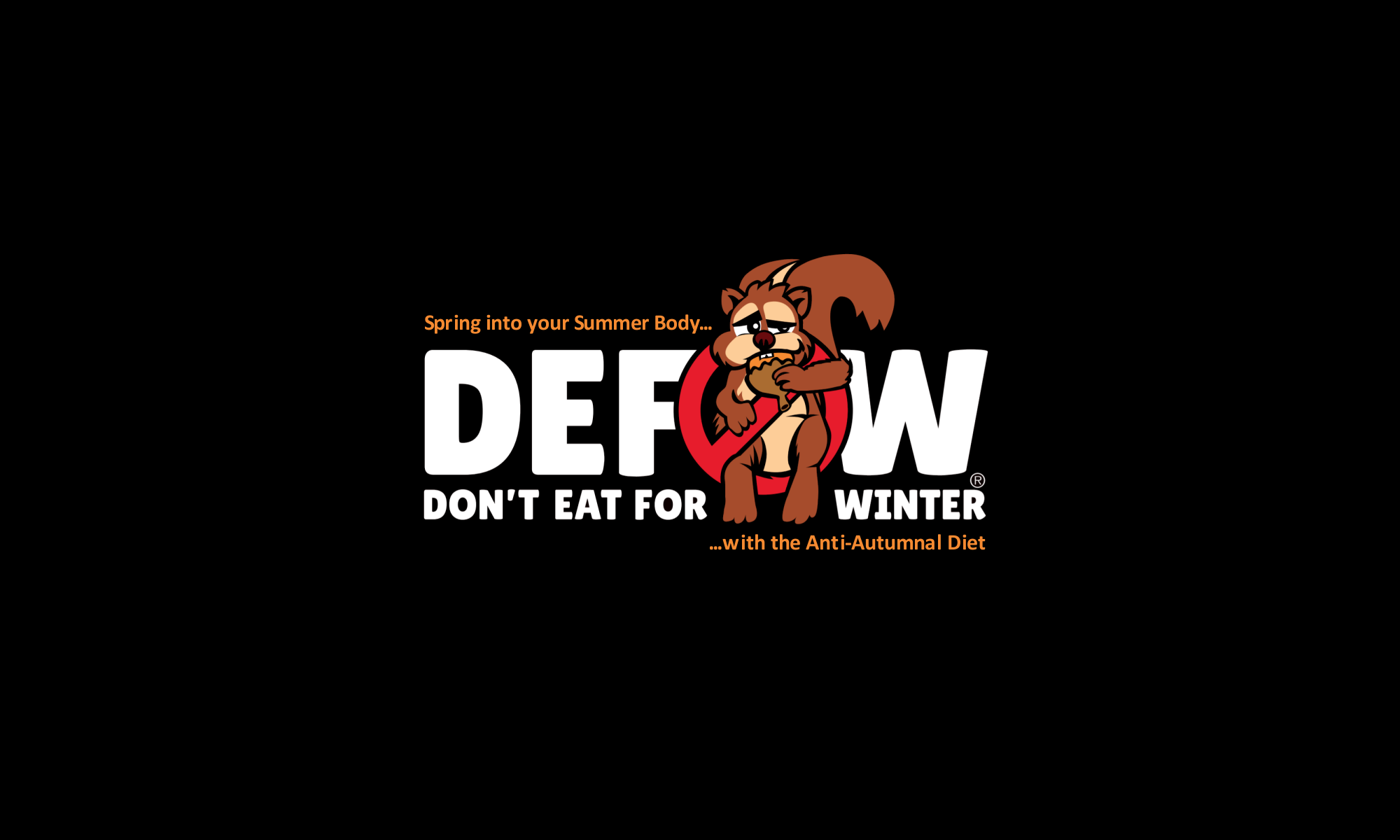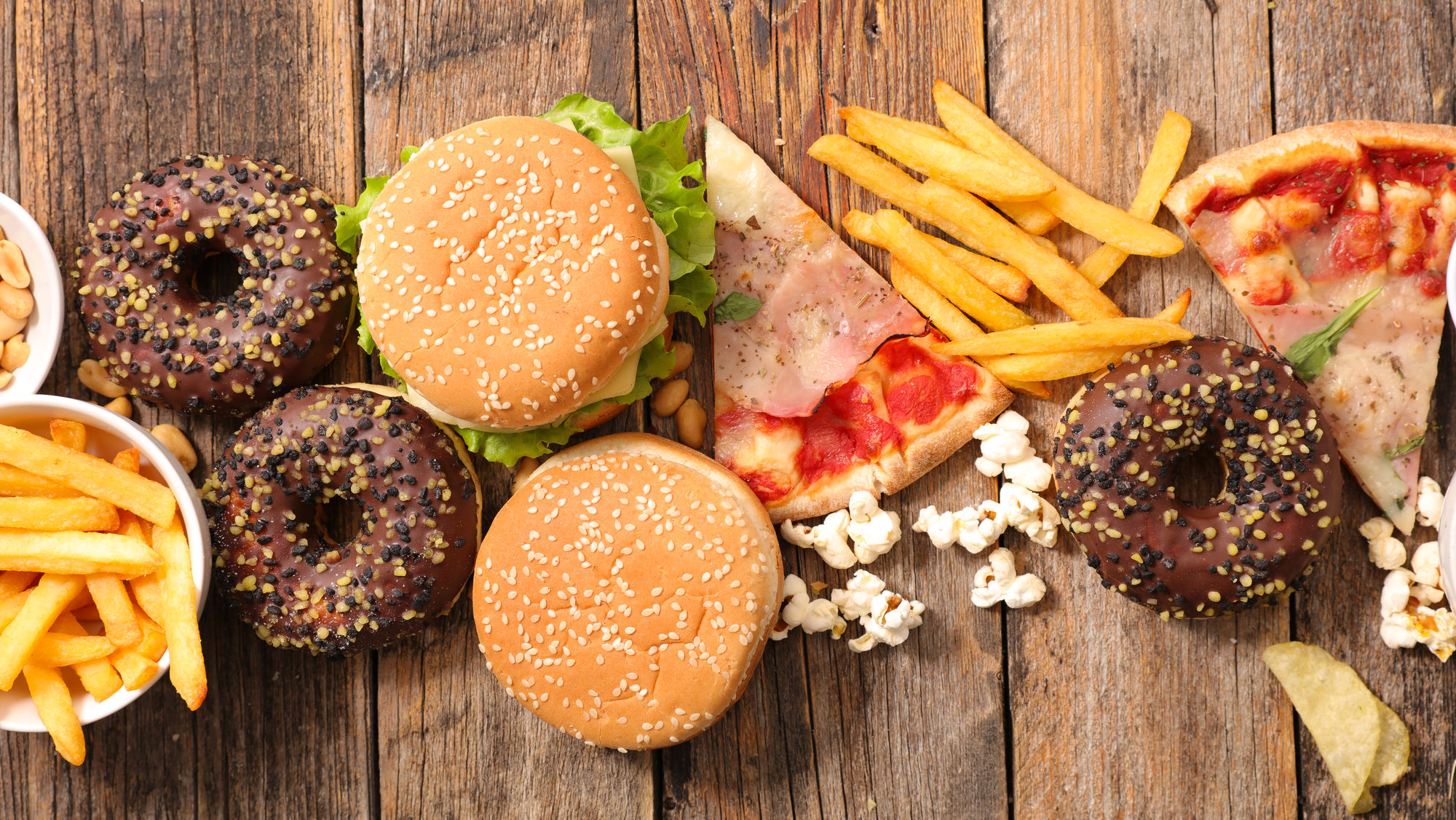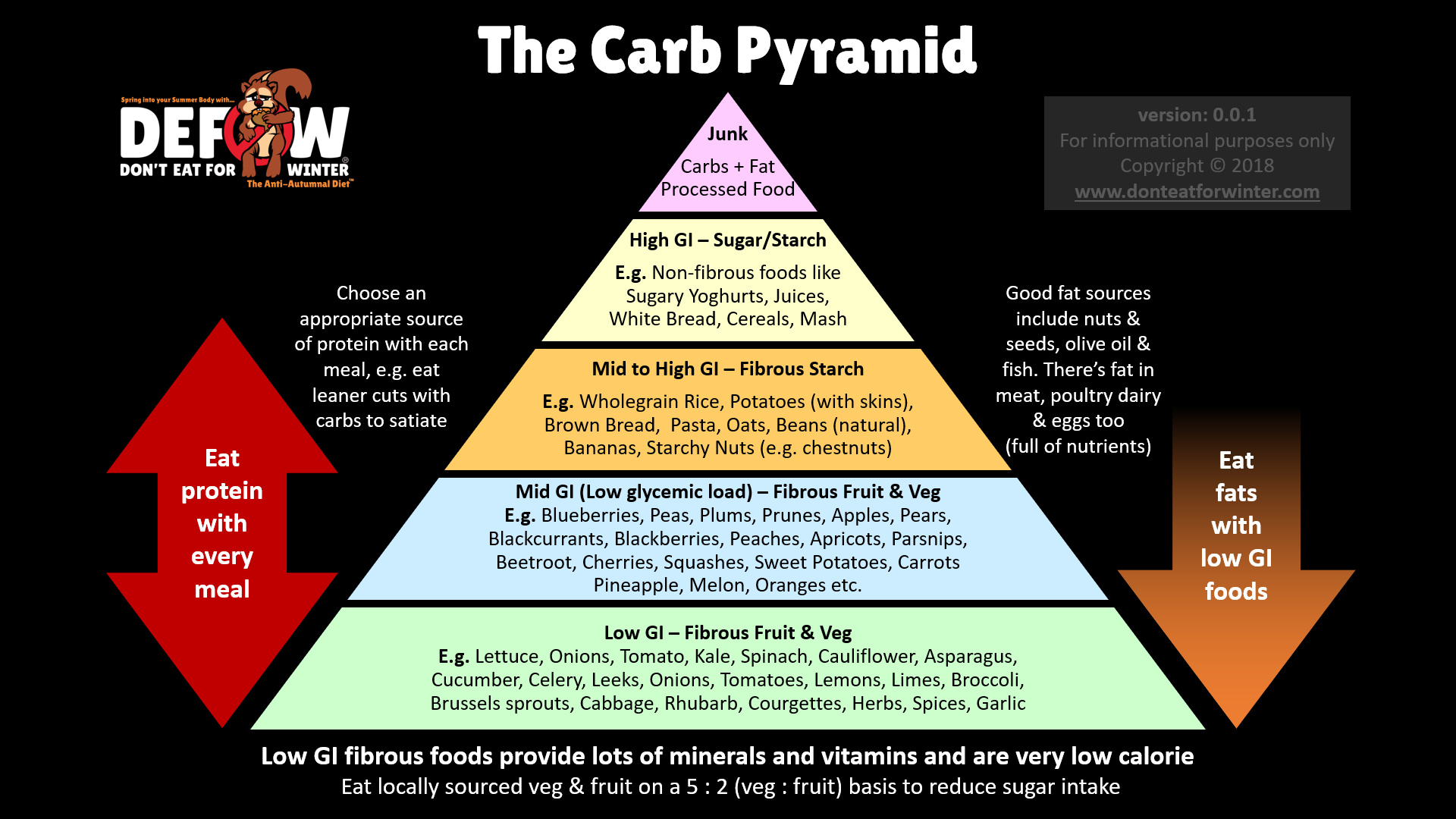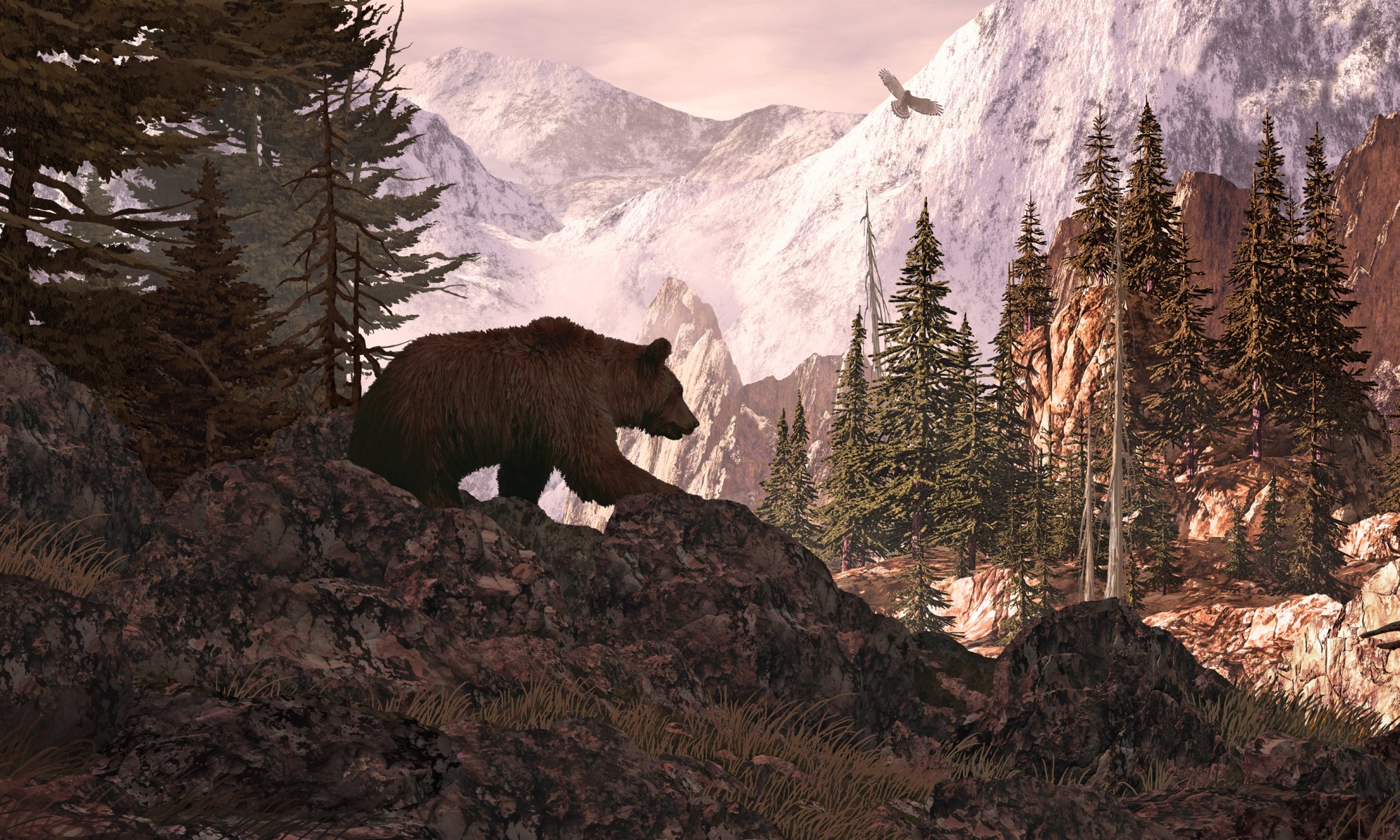What is hyperphagia anyway?
Well, according to Lexico.com (powered by Oxford), hyperphagia is:
“An abnormally great desire for food; excessive eating.”
Hyperphagia is a medical term, and of course, for some, this is a disorder that requires treatment. If you believe you suffer from a compulsion to over-eat in an abnormal way, as always, consult with your physician.
I believe hyperphagia is commonplace among humans. Some are affected by it more than others. I suggest that this is why we see so many people battling with weight through exercise, supplements, fad diets and so on over the course of their lives.
It is just as difficult for us to out-run as it is for a squirrel to out-scurry in autumn.
I believe hyperphagia among humans is exploited and it is why we now have 24-hour drive-through doughnut joints, fast food chains, and shops decorated like Christmas trees with all sorts of sparkly niceties in our faces no matter where we go. We have nowhere to hide in this hyper-processed junk food gauntlet.
Excessive consumption of junk food is commonplace. We are junk food junkies. So, let’s explore my ideas regarding why this is the case.
Hyperphagia in the Animal Kingdom
Many animals instinctively bulk up in autumn time to survive winter. Some animals store food externally as a strategy, but many store it internally in the form of body-fat, which can act as both an insulation layer and/or energy buffer to survive the cold until winter ends and spring comes. Different animals use different strategies.
Examples include:
- Bears: Bears put on large amounts of fat in autumn time (and can double their body weight) and then hibernate for up to 6 months to bypass winter and live off fat stores. Their source of food changes during the year and the chart on the following page gives an indication of what is available to them during the weeks before they hibernate (see http://wiseaboutbears.org/black-bears/the-bear-family/a-bears-quest-for-food).
- Pigs: Acorn fattened pigs breeds develop “fatback”, inches of fat on their backs, which I can only assume acts as a thermal blanket (see http://www.mast-producing-trees.org/2009/11/acorn-finished-pork-an-ancient-tradition/).
- Squirrel: Squirrels store food but also plump up using both strategies to survive winter. Red squirrels put up about 12% and grey squirrels up to 25% according to https://www.wildlifeworld.co.uk/squirrels
- Deer: Deer also put on weight to get through winter, anywhere from 20 to 30% of their body weight as fat according to PennState College of Agricultural Sciences and have acorns as a main source of food in autumn (see https://www.realtree.com/deer-hunting/articles/everything-you-need-to-know-about-acorns)
- Woodpeckers: some non-storing breeds undergo winter fattening using acorns (see https://www.jstor.org/stable/4096482?seq=1#page_scan_tab_contents).
There are many other animals that gain weight using different food combination available in their environment in autumn. These are just an obvious selection. One of the most common foods these animals use during this fattening period is acorns. The interesting thing about acorns is the macro-nutrient ratio is unique in a single food in nature at 53% fat, 41% carb and 6% protein (more on that later).
The animals have different survival strategies, but the net effect is the same. They become uncontrollably hyperphagic first, and so instinctively eat and eat and eat, adding bodyweight to survive winter using their respective strategies. Some remain active, some rest more, some enter full hibernation.
Are humans seasonal creatures too?
Recently, we are learning a lot about our circadian biology (24 hour cycle). Many of our biological functions are locked into this daily cycle, and many things like sleep and insulin sensitivity work better when we respect this rhythm. But do we also have a yearly biological rhythm that follows the seasons like these animals that instinctively store fat for winter?
It can be shown that humans are seasonally adapted in many ways. Not all of us are the same, but across the species, we have varying seasonal abilities. E.g. we can develop a tan, which is essentially a regulator for the synthesis of vitamin D3. We tan under strong sunlight, to reduce the amount of sunlight that is absorbed and this regulates the production of D3 from cholesterol as a result.
It was also recently discovered that we can develop and activate brown adipose tissue, or BAT, a layer around our necks and shoulders, which facilitates non-shivering thermogenesis (NST) and allows us to remain warm, in cold environments, so that we do not fall victim to hypothermia so easily. This becomes more active the more we are exposed to cold. BAT is an internal heater and thermal insulation layer that humans are born with, but that reduces as we age, perhaps because of non-activation due to warm homes and clothing.
The interesting thing about BAT is that it responds and activates not only by cold, but also by diet (Saito M. et al), and I believe the dietary conditions for this are just right in autumn.
According to a study by Dodd et. al “leptin or insulin ICV infusion alone had little effect on browning, respectively, whereas the co-infusion of insulin and leptin strikingly enhanced browning. In contrast to WAT browning, we found that BAT activity was enhanced by 2–3 fold in response to leptin.”
If you think about the circannual (yearly) harvest cycle, insulin (a hormonal response induced by blood sugar levels) and leptin (fat level hormonal response) should be highest in autumn when carbs are at their maximum in the form of fruit, grains; and nuts also as they harvest alongside the presence of fatter meats (like the pigs and deer mentioned above who fatten during this period). Not long into winter, carbs perish so the insulin response would be less chronic and lower in amplitude, but leptin would be left high due to higher body fat levels and continued consumption of fatty meats. This means through diet, browning of WAT may occur in autumn as carb+fat combinations are available, and subsequently fired up by cold and leptin levels when dietary carbohydrates wane. I think it’s not a stretch to suggest that this is exactly what happens naturally during the transition from autumn into winter.
“Whoever wishes to investigate medicine properly, should proceed thus: in the first place to consider the seasons of the year, and what effects each of them produces, for they are not at all alike…” – Hippocrates
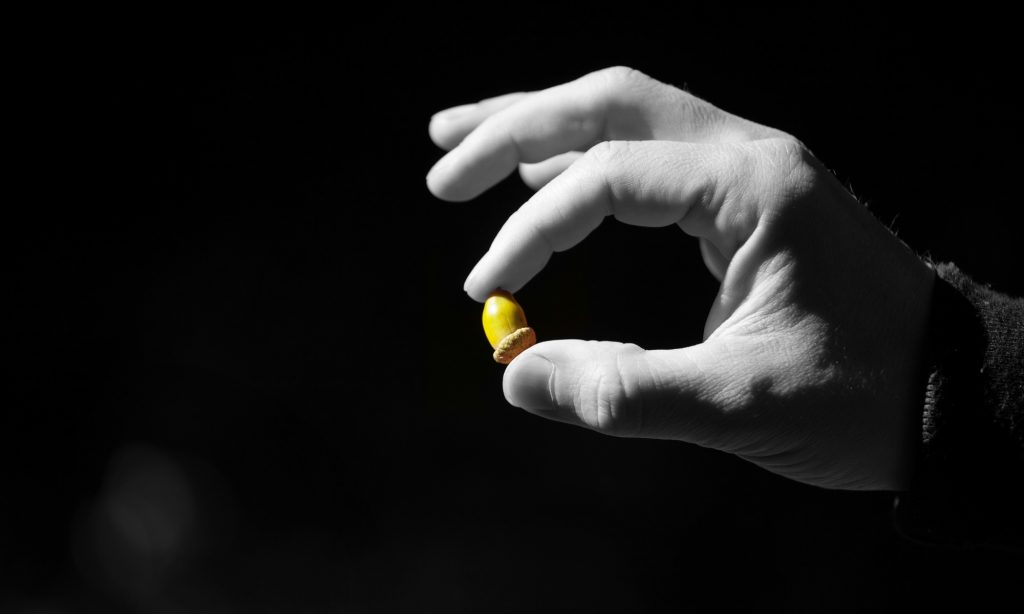
What’s so Special about Acorns?
Acorns are a signature of autumn, the harvest of the lofty oak tree, which is prolific across many continents and vast areas of the Earth. It has the perfect combination of fat:carb:protein to provide the nutrition required to fatten various species. After the ice age, these magnificent trees spread across the earth over thousands of years and provided shelter and food for a vast array of creatures including human beings. It must have been and incredible environment.
I believe the circannual rhythm also acts as a driver for hyperphagia in animals, among other food combinations that occur in autumn. Animals do not choose to eat more. Instinct compels them to. They do not consciously know that winter is coming, However, they are evolutionarily adapted to obey the signals in their environment.
While we like to think that we are not animals and we are in conscious control of our actions, anyone who has tried to lose weight and keep it off will tell you that we are anything but in conscious control of our eating behaviour. In the long term, our survival instincts win out over our conscious mind.
I believe that this signature drives humans into a hyperphagic mode also. Humans are creatures too and are driven by instinct when it comes to mating, eating and pretty much everything relating to survival.
We like salt, sugar, fat etc., but we value carb+fat more than any other combination This study from Yale, by Dana Small et al.) have shown that it is the most valued combination by humans, but you only need to think about it to realise it is true. Pizza, chocolate, ice-cream, cheese+crackers, fries, deep-fried breaded chicken, doughnuts, pastries, fried rice etc. all sell like hotcakes, which incidentally are a carb+fat combo too).
Humans don’t eat acorns anymore as we need to process acorns to make them palatable (remove tannic acid through boiling/soaking), and they are expensive to harvest. However, they were used by Native Americans for over 4000 years (https://www.archives.gov/education/lessons/acorn) and are still used in traditional recipes today. Celts ate them too when Ireland was 100% forested, and the Oak tree was revered. Interestingly, from the book, ‘The Celts: A History’ by Daithi O Hogain, it suggests that the Celtic warriors had to be very careful not to get fat or risk being fined! The battle of the bulge is not a new thing, and perhaps all the acorns caused them these weight gain issues.
It is not just acorns that cause hyperphagia in the animal kingdom, but rather the macronutrient signature. Interestingly, it matches just one other natural food in the USDA food composition database in an uncanny way, and that is human breast milk, a food that is vital to the survival of humans during a harsh period (moving from fluids to solids during infancy). Babies gorge and refeed on milk regularly. Instinct has them hyperphagic in order to grow at a dramatic rate during the first few months of life in the outside world.
Autumn may have required humans to bulk too in order to create an energy buffer and also as a thermal insulation layer and fuel source for energy-hungry brown adipose tissue.
The signature macronutrient profile of acorns is 53% fat, 41% carbohydrate and 6% protein. One of the observations of Don’t Eat for Winter (find out more about the book here) is that many junk foods match this signature in an uncanny way.
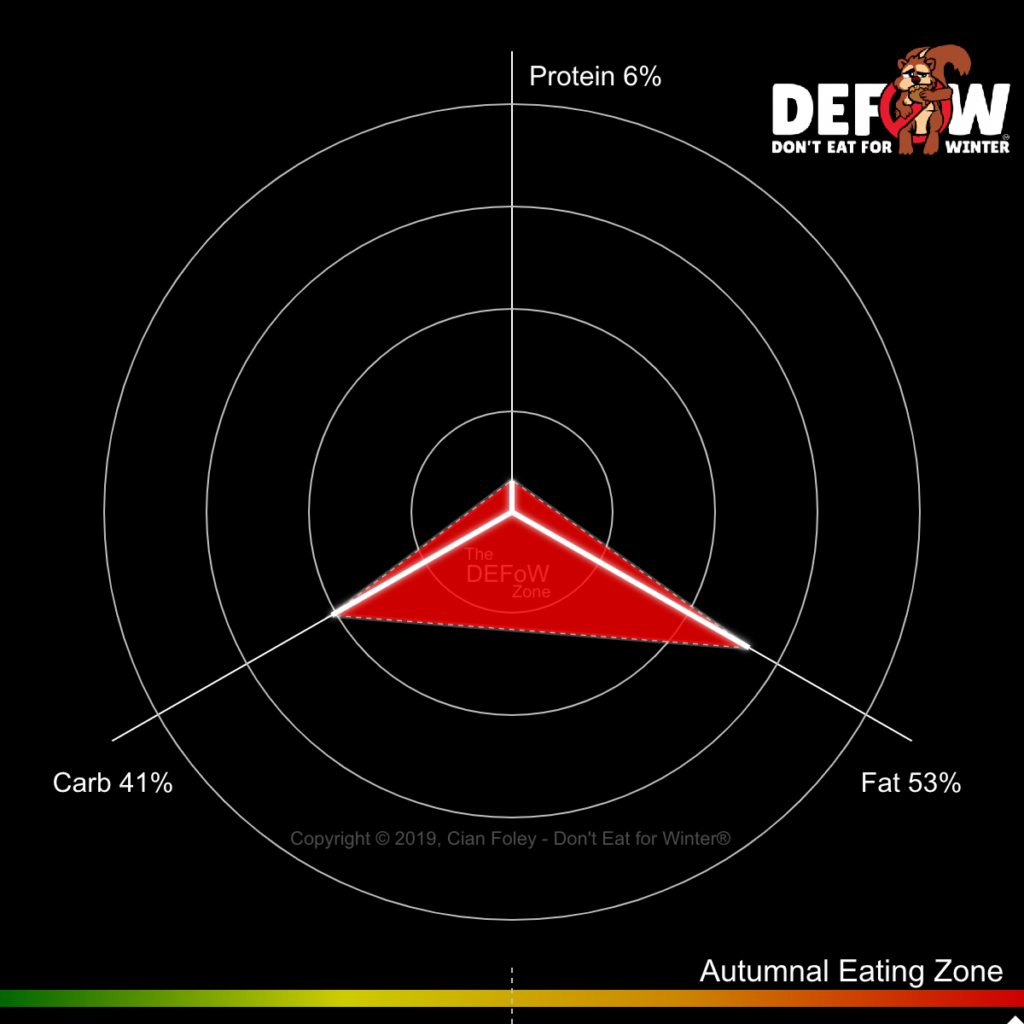
The above image is from a tool I created called D.A.D.A.R (DEFoW Autumnal Diet Avoidance Radar) that is being developed (you can check out the beta release at of D.A.D.A.R on www.defowdiet.com). This shows how close a is to the autumnal macro-nutrient signature of an Acorn. In the book Don’t Eat for Winter, I term this ‘The Squirrel Formula’.
After developing the tool and searching for and ordering foods closest in proximity to the signature it yielded an abundance of junk food, which I believe has strengthened the autumnal macronutrient ratio hyperphagia hypothesis (see list of top 200 foods below and judge for yourself).
Using the tool, it is very easy to determine how autumnal a particular food is, and I suggest that eating for seasons other than autumn (i.e. winter (low carb / keto), summer (low fat) or spring (high protein), leads to more satiety and as a result less fat gain or fat loss.
There are many hormonal responses when we eat this combination driving insulin, leptin up, causing ghrelin rebound, releasing dopamine among other responses. We value with by sight, smell, taste and we are affected hormonally. All of this can be described simply as instinct.
For further reading, Marty Kendal of Optimising Nutrition has an excellent article here on the subject. Marty also believes that carbs+fats should be watched in the diet and the focus should be on nutrient density.
Dr Ted Naiman also has an excellent tool called the Protein to Energy Ratio, which again prefers lowering carb+fat intake, while increasing protein. The net effect is carbs+fats should be watched in the diet.
Top 200 Most Autumnal Foods according to DEFoW Squirrel Formula
Following is a list of the 200 most autumnal foods in the USDA Food Composition Database according to distance from Don’t Eat for Winter’s ‘Squirrel formula’ (precisely 53% fat, 41% carb and 6% protein from a calorie point of view).
The USDA Food Composition Database is a database of thousands of foods with their composition data, i.e. macro and micronutrient breakdowns.
This list searches are items from the standard reference (i.e. general foods without specific manufacturer products listed) and compares them to the macronutrient signature of acorns. You can use the tool to insert macros manually from nutritional labels to discover it’s the distance from this macronutrient ratio.
These are single food items, and it does not compare mixtures or recipes (as yet). It simply scores them and orders them in terms of proximity to the formula.
The list shows foods that are extremely attractive to humans and should strengthen the case that foods high in both carbs+fat causes a similar reaction in human beings. We are drawn to such foods just as bears, pigs, squirrels deer and other creatures are to acorns and other combinations of fruits and nuts in autumn time.
Perhaps eating autumnally causes hyperphagia in us too…
So maybe the best advice is simply to be careful foods with the autumnal signature of high carb+fat together if they may cause you to overeat. If you can’t stop, don’t start (especially not with junk foods and definitely not every day).
Don’t Eat for Winter!
| Position | Food Item | Proximity to Squirrel Formula |
| 1 | Nuts, acorns, raw | 1 |
| 2 | Ice creams, regular, low carbohydrate, vanilla | 0.99 |
| 3 | Candies, carob, unsweetened | 0.99 |
| 4 | Snacks, potato chips, barbecue-flavor | 0.99 |
| 5 | Candies, milk chocolate coated coffee beans | 0.98 |
| 6 | Danish pastry, nut (includes almond, raisin nut, cinnamon nut) | 0.98 |
| 7 | Pie crust, standard-type, dry mix, prepared, baked | 0.98 |
| 8 | Nuts, acorn flour, full fat | 0.98 |
| 9 | Pie crust, standard-type, dry mix | 0.98 |
| 10 | Noodles, chinese, chow mein | 0.98 |
| 11 | Milk, human, mature, fluid | 0.98 |
| 12 | Candies, crispy bar with peanut butter filling | 0.98 |
| 13 | Whipped topping, frozen, low fat | 0.98 |
| 14 | Popcorn, microwave, regular (butter) flavor, made with palm oil | 0.98 |
| 15 | Snacks, popcorn, microwave, regular (butter) flavor, made with partially hydrogenated oil | 0.98 |
| 16 | Snacks, corn-based, extruded, chips, barbecue-flavor | 0.98 |
| 17 | Snacks, corn-based, extruded, chips, barbecue-flavor, made with enriched masa flour | 0.98 |
| 18 | Cookies, brownies, prepared from recipe | 0.98 |
| 19 | Granola bar, soft, milk chocolate coated, peanut butter | 0.98 |
| 20 | Restaurant, Latino, bunuelos (fried yeast bread) | 0.98 |
| 21 | Snacks, potato chips, sour-cream-and-onion-flavor | 0.98 |
| 22 | Candies, milk chocolate, with almonds | 0.97 |
| 23 | Spices, mace, ground | 0.97 |
| 24 | Pie crust, standard-type, frozen, ready-to-bake, enriched | 0.97 |
| 25 | Ice creams, french vanilla, soft-serve | 0.97 |
| 26 | Doughnuts, yeast-leavened, glazed, unenriched (includes honey buns) | 0.97 |
| 27 | Frozen novelties, ice cream type, chocolate or caramel covered, with nuts | 0.97 |
| 28 | Snacks, corn-based, extruded, cones, nacho-flavor | 0.97 |
| 29 | Snacks, popcorn, cheese-flavor | 0.97 |
| 30 | Pie crust, deep dish, frozen, unbaked, made with enriched flour | 0.97 |
| 31 | Snacks, corn-based, extruded, chips, unsalted | 0.97 |
| 32 | Soup, cream of celery, canned, prepared with equal volume water | 0.97 |
| 33 | Fast foods, nachos, with cinnamon and sugar | 0.97 |
| 34 | Snacks, potato sticks | 0.97 |
| 35 | Soup, cream of celery, canned, condensed | 0.97 |
| 36 | Pie crust, deep dish, frozen, baked, made with enriched flour | 0.97 |
| 37 | Nuts, almond paste | 0.97 |
| 38 | Snacks, potato chips, plain, made with partially hydrogenated soybean oil, salted | 0.97 |
| 39 | Snacks, potato chips, plain, made with partially hydrogenated soybean oil, unsalted | 0.97 |
| 40 | Snacks, potato chips, plain, unsalted | 0.97 |
| 41 | Pinon Nuts, roasted (Navajo) | 0.97 |
| 42 | Doughnuts, cake-type, plain (includes unsugared, old-fashioned) | 0.97 |
| 43 | Snacks, granola bars, soft, coated, milk chocolate coating, peanut butter | 0.97 |
| 44 | Coffeecake, cinnamon with crumb topping, commercially prepared, enriched | 0.96 |
| 45 | Coffeecake, cinnamon with crumb topping, commercially prepared, unenriched | 0.96 |
| 46 | Noodles, flat, crunchy, Chinese restaurant | 0.96 |
| 47 | Pie, chocolate mousse, prepared from mix, no-bake type | 0.96 |
| 48 | Candies, milk chocolate | 0.96 |
| 49 | Danish pastry, cinnamon, enriched | 0.96 |
| 50 | Danish pastry, cinnamon, unenriched | 0.96 |
| 51 | Candies, dark chocolate coated coffee beans | 0.96 |
| 52 | Candies, white chocolate | 0.96 |
| 53 | Candies, milk chocolate, with rice cereal | 0.96 |
| 54 | Pie crust, standard-type, frozen, ready-to-bake, enriched, baked | 0.96 |
| 55 | Snacks, corn-based, extruded, puffs or twists, cheese-flavor, unenriched | 0.96 |
| 56 | Onion rings, breaded, par fried, frozen, prepared, heated in oven | 0.96 |
| 57 | Potatoes, o’brien, frozen, prepared | 0.96 |
| 58 | Cookies, peanut butter sandwich, special dietary | 0.96 |
| 59 | Snacks, popcorn, oil-popped, white popcorn | 0.96 |
| 60 | Fast foods, onion rings, breaded and fried | 0.95 |
| 61 | Ice creams, vanilla, rich | 0.95 |
| 62 | Ice creams, regular, low carbohydrate, chocolate | 0.95 |
| 63 | Pie, coconut cream, prepared from mix, no-bake type | 0.95 |
| 64 | Snacks, popcorn, home-prepared, oil-popped, unsalted | 0.95 |
| 65 | Doughnuts, yeast-leavened, with jelly filling | 0.95 |
| 66 | Keikitos (muffins), Latino bakery item | 0.95 |
| 67 | Pie crust, cookie-type, prepared from recipe, chocolate wafer, chilled | 0.95 |
| 68 | Snacks, granola bar, with coconut, chocolate coated | 0.95 |
| 69 | Snacks, potato chips, cheese-flavor | 0.95 |
| 70 | Cookies, peanut butter, refrigerated dough | 0.95 |
| 71 | Cookies, peanut butter, refrigerated dough, baked | 0.95 |
| 72 | Tomatoes, sun-dried, packed in oil, drained | 0.95 |
| 73 | Danish pastry, cheese | 0.95 |
| 74 | Snacks, potato chips, plain, salted | 0.95 |
| 75 | Snacks, potato chips, made from dried potatoes, cheese-flavor | 0.95 |
| 76 | Snacks, potato chips, made from dried potatoes, sour-cream and onion-flavor | 0.95 |
| 77 | Pie crust, standard-type, prepared from recipe, unbaked | 0.95 |
| 78 | Ice creams, vanilla | 0.95 |
| 79 | Pie crust, standard-type, prepared from recipe, baked | 0.95 |
| 80 | Snacks, corn-based, extruded, puffs or twists, cheese-flavor | 0.94 |
| 81 | Whipped cream substitute, dietetic, made from powdered mix | 0.94 |
| 82 | Cookies, shortbread, commercially prepared, pecan | 0.94 |
| 83 | Potatoes, mashed, dehydrated, prepared from flakes without milk, whole milk and butter added | 0.94 |
| 84 | Candies, sesame crunch | 0.94 |
| 85 | Potatoes, frozen, french fried, par fried, extruded, unprepared | 0.94 |
| 86 | Fast foods, potato, baked and topped with sour cream and chives | 0.94 |
| 87 | Doughnuts, cake-type, plain, chocolate-coated or frosted | 0.94 |
| 88 | Soup, cream of vegetable, dry, powder | 0.94 |
| 89 | Pie crust, standard-type, frozen, ready-to-bake, unenriched | 0.94 |
| 90 | Cookies, chocolate chip, prepared from recipe, made with butter | 0.94 |
| 91 | Cream substitute, powdered | 0.94 |
| 92 | Chocolate, dark, 45- 59% cacao solids | 0.94 |
| 93 | Candies, truffles, prepared-from-recipe | 0.94 |
| 94 | Cookies, chocolate chip, prepared from recipe, made with margarine | 0.94 |
| 95 | Chocolate, dark, 60-69% cacao solids | 0.94 |
| 96 | Alcoholic beverage, liqueur, coffee with cream, 34 proof | 0.94 |
| 97 | Doughnuts, cake-type, wheat, sugared or glazed | 0.94 |
| 98 | Spices, nutmeg, ground | 0.94 |
| 99 | Potato pancakes | 0.94 |
| 100 | Cheese, gjetost | 0.94 |
| 101 | Pie, chocolate creme, commercially prepared | 0.94 |
| 102 | Fast foods, potatoes, hashed brown | 0.93 |
| 103 | Onion rings, breaded, par fried, frozen, unprepared | 0.93 |
| 104 | Pie, vanilla cream, prepared from recipe | 0.93 |
| 105 | Side dishes, potato salad | 0.93 |
| 106 | Chocolate-flavored hazelnut spread | 0.93 |
| 107 | Dessert topping, powdered, 1.5 ounce prepared with 1/2 cup milk | 0.93 |
| 108 | Potatoes, frozen, french fried, par fried, extruded, prepared, heated in oven, without salt | 0.93 |
| 109 | Doughnuts, cake-type, plain, sugared or glazed | 0.93 |
| 110 | Snacks, tortilla chips, nacho cheese | 0.93 |
| 111 | Croissants, butter | 0.93 |
| 112 | Snack, potato chips, made from dried potatoes, plain | 0.93 |
| 113 | Fast foods, french toast sticks | 0.93 |
| 114 | Pie crust, cookie-type, prepared from recipe, vanilla wafer, chilled | 0.93 |
| 115 | Creamy dressing, made with sour cream and/or buttermilk and oil, reduced calorie, cholesterol-free | 0.93 |
| 116 | Snacks, corn-based, extruded, chips, plain | 0.93 |
| 117 | Candies, sweet chocolate | 0.92 |
| 118 | Dessert topping, powdered | 0.92 |
| 119 | Salad dressing, mayonnaise, imitation, milk cream | 0.92 |
| 120 | Puff pastry, frozen, ready-to-bake, baked | 0.92 |
| 121 | Crackers, standard snack-type, regular, low salt | 0.92 |
| 122 | Snacks, granola bars, hard, almond | 0.92 |
| 123 | Snacks, tortilla chips, nacho-flavor, made with enriched masa flour | 0.92 |
| 124 | Puff pastry, frozen, ready-to-bake | 0.92 |
| 125 | Pie, banana cream, prepared from recipe | 0.92 |
| 126 | Nuts, coconut meat, dried (desiccated), sweetened, flaked, packaged | 0.92 |
| 127 | Pie crust, refrigerated, regular, unbaked | 0.92 |
| 128 | Pie crust, refrigerated, regular, baked | 0.92 |
| 129 | Candies, milk chocolate coated peanuts | 0.92 |
| 130 | Gravy, mushroom, canned | 0.92 |
| 131 | Potato salad, home-prepared | 0.92 |
| 132 | Fast foods, coleslaw | 0.92 |
| 133 | Crackers, standard snack-type, regular | 0.92 |
| 134 | Salad dressing, buttermilk, lite | 0.92 |
| 135 | Salad dressing, ranch dressing, reduced fat | 0.92 |
| 136 | Eclairs, custard-filled with chocolate glaze, prepared from recipe | 0.92 |
| 137 | Candies, semisweet chocolate | 0.92 |
| 138 | Candies, semisweet chocolate, made with butter | 0.92 |
| 139 | Nuts, coconut meat, dried (desiccated), sweetened, flaked, canned | 0.92 |
| 140 | Soup, broccoli cheese, canned, condensed, commercial | 0.92 |
| 141 | Potatoes, hashed brown, frozen, plain, prepared | 0.92 |
| 142 | Bread stuffing, cornbread, dry mix, prepared | 0.92 |
| 143 | Crackers, cheese, low sodium | 0.92 |
| 144 | Crackers, cheese, regular | 0.92 |
| 145 | Cake, pound, commercially prepared, butter | 0.92 |
| 146 | Crackers, wheat, sandwich, with cheese filling | 0.92 |
| 147 | Crackers, cheese, sandwich-type with cheese filling | 0.92 |
| 148 | Nuts, coconut meat, dried (desiccated), sweetened, shredded | 0.92 |
| 149 | Soup, mushroom, dry, mix, prepared with water | 0.91 |
| 150 | Doughnuts, yeast-leavened, with creme filling | 0.91 |
| 151 | Snacks, corn-based, extruded, cones, plain | 0.91 |
| 152 | Soup, cream of chicken, dry, mix, prepared with water | 0.91 |
| 153 | Pie, pecan, prepared from recipe | 0.91 |
| 154 | Fast foods, potato, french fried in vegetable oil | 0.91 |
| 155 | Pie, banana cream, prepared from mix, no-bake type | 0.91 |
| 156 | Cookies, peanut butter, commercially prepared, soft-type | 0.91 |
| 157 | Croissants, cheese | 0.91 |
| 158 | Candies, confectioner’s coating, yogurt | 0.91 |
| 159 | Sweet rolls, cheese | 0.91 |
| 160 | Soup, cream of mushroom, low sodium, ready-to-serve, canned | 0.91 |
| 161 | Fast foods, danish pastry, cheese | 0.91 |
| 162 | Snacks, sesame sticks, wheat-based, salted | 0.91 |
| 163 | Snacks, sesame sticks, wheat-based, unsalted | 0.91 |
| 164 | Snacks, tortilla chips, ranch-flavor | 0.91 |
| 165 | Fast foods, nachos, with cheese | 0.91 |
| 166 | Snacks, tortilla chips, taco-flavor | 0.91 |
| 167 | Ice creams, chocolate, rich | 0.91 |
| 168 | Pie, coconut custard, commercially prepared | 0.91 |
| 169 | Pastry, Pastelitos de Guava (guava pastries) | 0.91 |
| 170 | Ice creams, chocolate | 0.91 |
| 171 | Cookies, peanut butter, prepared from recipe | 0.91 |
| 172 | Danish pastry, fruit, enriched (includes apple, cinnamon, raisin, lemon, raspberry, strawberry) | 0.91 |
| 173 | Danish pastry, fruit, unenriched (includes apple, cinnamon, raisin, strawberry) | 0.91 |
| 174 | Danish pastry, lemon, unenriched | 0.91 |
| 175 | Danish pastry, raspberry, unenriched | 0.91 |
| 176 | Chocolate, dark, 70-85% cacao solids | 0.91 |
| 177 | Doughnuts, yeast-leavened, glazed, enriched (includes honey buns) | 0.91 |
| 178 | Bread stuffing, bread, dry mix, prepared | 0.91 |
| 179 | Pie, egg custard, commercially prepared | 0.91 |
| 180 | Restaurant, family style, French fries | 0.9 |
| 181 | Crackers, wheat, sandwich, with peanut butter filling | 0.9 |
| 182 | Muffins, blueberry, commercially prepared (Includes mini-muffins) | 0.9 |
| 183 | Salad dressing, home recipe, cooked | 0.9 |
| 184 | Pie, coconut creme, commercially prepared | 0.9 |
| 185 | Fast foods, griddle cake sandwich, sausage | 0.9 |
| 186 | Soup, chicken vegetable with potato and cheese, chunky, ready-to-serve | 0.9 |
| 187 | Cream puffs, prepared from recipe, shell, with custard filling | 0.9 |
| 188 | Cheesecake commercially prepared | 0.9 |
| 189 | Snacks, banana chips | 0.9 |
| 190 | Cookies, sugar, prepared from recipe, made with margarine | 0.9 |
| 191 | Crackers, cheese, sandwich-type with peanut butter filling | 0.9 |
| 192 | Potatoes, mashed, prepared from flakes, without milk, whole milk and margarine | 0.9 |
| 193 | Cookies, peanut butter, commercially prepared, regular | 0.9 |
| 194 | Snacks, plantain chips, salted | 0.9 |
| 195 | Salad dressing, thousand island dressing, reduced fat | 0.9 |
| 196 | Candies, praline, prepared-from-recipe | 0.9 |
| 197 | Snacks, granola bars, soft, coated, milk chocolate coating, chocolate chip | 0.9 |
| 198 | Coffee, dry, powder, with whitener, reduced calorie | 0.9 |
| 199 | Snacks, popcorn, oil-popped, microwave, regular flavor | 0.9 |
| 200 | Crackers, standard snack-type, sandwich, with peanut butter filling | 0.9 |
